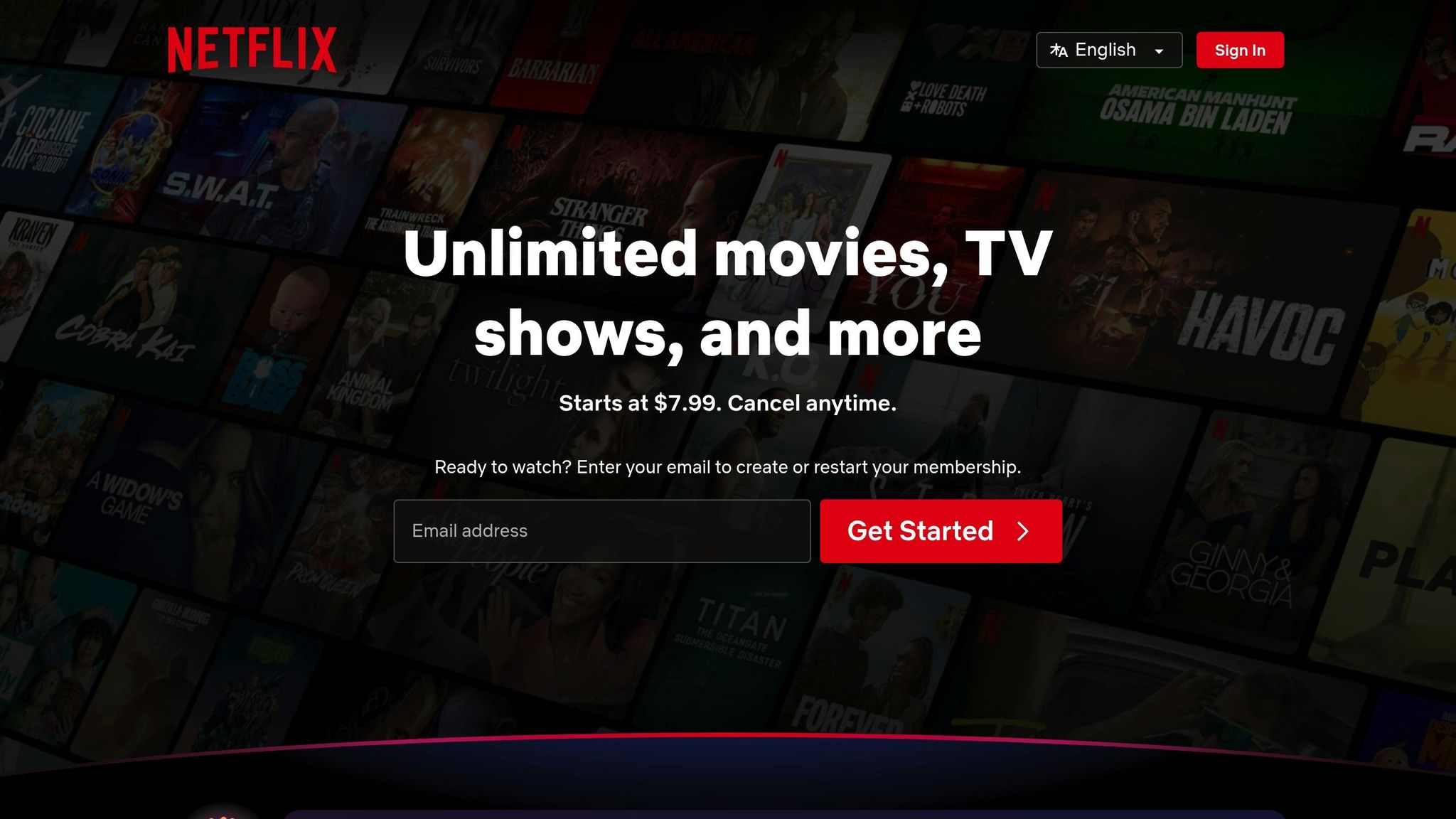AI is revolutionizing how businesses create content in 2025. Companies are saving time, cutting costs, and scaling faster by integrating AI tools into their workflows. Here's a quick summary of how AI is transforming content creation:
- Time Savings: AI reduces content creation time by up to 30-80%. For example, a 500-word blog post that takes 4 hours manually can be done 30% faster with AI.
- Cost Reduction: Businesses using AI save 30-60% on marketing and content production costs.
- SEO & Engagement: AI-driven campaigns boost organic traffic by 45% and conversion rates by 38%.
- Personalization: Tools like Netflix's AI optimize user experiences with personalized recommendations and visuals.
- Scalability: AI automates keyword research, drafts, and even repurposes content for social media, enabling businesses to scale without increasing team sizes.
Quick Benefits of AI in Content Creation:
- Efficiency: Produce content 10x faster.
- Cost Savings: Cut costs by up to 62%.
- Engagement: Improve user engagement by 41%.
- SEO: Enhance search rankings with AI-optimized long-form content.
AI tools like Jasper, Writesonic, and ChatGPT are helping businesses streamline their content strategies, whether it's creating blog posts, repurposing videos, or optimizing SEO. Companies like Alibaba, Netflix, and DoorDash are already seeing measurable results, from faster production times to increased sales and engagement. The future of content creation is here, and AI is leading the charge.
AI Tools for Content Creation: The Future of Marketing (2025)
The Business Impact of AI-Powered Content Creation
AI-powered content creation is reshaping how U.S. businesses approach efficiency, cost management, and scalability. Companies are achieving results that go far beyond saving time. By improving traditional long-form content, AI allows businesses to produce high-quality material quickly and at scale. This shift is happening rapidly, with 73% of businesses already leveraging AI for content creation. These numbers highlight AI's growing role in modern content strategies.
The financial impact is equally impressive. Companies are cutting content creation costs by 30–60%, with some reporting savings as high as 62%. This cost efficiency is fundamentally changing how businesses allocate resources and plan their content strategies.
Key Benefits of AI in Content Creation
AI tools are transforming efficiency. They enable content production up to 10 times faster than traditional methods and can reduce revision cycles by up to 40%. This speed advantage helps businesses respond quickly to market demands and maintain output - even with smaller teams.
Take Forbes, for instance. By combining AI tools with human oversight, they cut content production time by 75% while maintaining high standards. AI-generated marketing materials have also been shown to increase engagement rates by up to 41%, and 65% of technical writers report that AI tools simplify documentation tasks.
The productivity gains are undeniable. AI integration boosts overall productivity by 40%, reducing labor costs and accelerating project timelines. For example, a mid-sized tech company used AIContentPad to automate SEO, streamline workflows, and repurpose content - cutting production costs by 62% in the process.
AI also excels at scaling content across various platforms and formats. Businesses can now create captions for a week’s worth of social media posts in one session, generate multiple email campaign variations for A/B testing, or repurpose blog posts into video scripts - all without needing to expand their teams. These capabilities align with the growing adoption of AI in content creation, as reflected in market trends.
Market Data: The Rise of Generative AI
The generative AI market is growing at a remarkable pace, showcasing its value to businesses. By 2030, the global AI content creation market is projected to reach $12.3 billion, growing at a compound annual growth rate (CAGR) of 37%. This growth underscores both technological advancements and the strategic advantages businesses are already experiencing.
Adoption rates among major enterprises further highlight this trend. Seventy-five percent of Fortune 500 companies are either piloting or scaling AI content solutions, and 62% of CMOs are prioritizing AI tools for content creation. What was once experimental has now become a key part of business strategies.
AI’s influence spans many industries. In journalism, AI now generates up to 30% of financial and sports news, and automation could save publishers over $300 million annually by 2026. In digital publishing, 58% of outlets are using AI for editing or creating content. Even visual content is evolving, with 71% of social media images and 62% of small business logos now created using AI.
Real-world examples highlight AI’s transformative impact. Coca-Cola used AI for social listening and personalized content in its "Share a Coke" campaign, achieving 870% higher engagement and completing the campaign in weeks instead of months. HP used Dynamics 365 Copilot to prioritize leads, launching campaigns 50% faster and doubling customer engagement. Heinz leveraged DALL-E to create thousands of unique ketchup bottle designs, earning 800 million impressions - a 2,500% return on media spend - and driving 40–60% sales growth during its holiday campaign.
The data makes it clear: AI-powered content creation is no passing trend. It’s becoming the standard for businesses aiming to scale their content operations efficiently while maintaining quality and controlling costs.
Case Studies: How Businesses Use AI for Content Creation
These examples reveal how AI is reshaping content creation across industries. Let's dive into how three major companies have successfully integrated AI to tackle challenges and achieve tangible results.
Alibaba's AI Copywriting Tool for E-Commerce

Alibaba's marketing platform, Alimama, developed an AI-powered copywriting tool that uses deep learning and natural language processing. Trained on millions of examples from Tmall and Taobao, this tool allows brands to generate multiple variations of product copy simply by entering a product page link. It’s capable of producing an astounding 20,000 lines of copy per second, with options to tweak tone and style - whether promotional, functional, poetic, or even heartwarming.
This tool sees nearly a million daily uses across Alibaba-owned platforms. Shaozhang Ding, who oversees e-commerce for the Asia Pacific market at Esprit, praised its impact:
"The AI copywriter is a really amazing tool... Based on a massive database of existing copy and advanced AI technologies, the tool can reduce the repetitive and tedious copywriting workload for our teams."
The efficiency gained through this tool has directly boosted business outcomes. For example, Alibaba International's foreign trade SaaS revenue jumped 74% year-over-year after launching its AI tools. One success story is Deyang Machinery, which used Alibaba's AI Business Assistant and OKKI AI to create product names, descriptions, and multilingual introduction videos. The company also developed tailored product images for local markets, helping secure major international orders.
While Alibaba focuses on streamlining content creation, Netflix takes a different approach - enhancing user experiences through AI.
Netflix's AI-Generated Video Personalization

Netflix employs AI to elevate personalization on its platform. Its algorithms carefully analyze user behavior to recommend content and even adjust video thumbnails to match individual preferences. For instance, the same movie or show may have different thumbnails depending on a viewer's genre interests.
Netflix has also experimented with creating multiple trailers for shows like House of Cards, tailoring each version to appeal to specific audience segments. This strategy has proven effective, with 75% of Netflix viewers selecting content based on its personalized recommendations. With over 282 million subscribers across 190 countries spending an average of 3.2 hours daily on the platform, the impact of this approach is undeniable.
Netflix's research team summarized their strategy:
"Personalization starts on the homepage and extends beyond our product. This includes personalized messaging and app notifications to keep members informed and engaged." – Netflix Research
While Netflix focuses on personalization, DoorDash shows how AI can repurpose content for different audiences.
DoorDash's AI-Driven Social Media Content Repurposing
In 2025, DoorDash teamed up with Shuttlerock to repurpose long-form content for social media. Using AI tools, they transformed existing video assets into short, engaging reels aimed at football fans. The process involved identifying key moments from longer videos and reformatting them into vertical clips, complete with suggested hashtags and captions. This allowed DoorDash to maximize the value of its existing content while catering to diverse platforms.
Additionally, DoorDash expanded its advertising capabilities by acquiring Symbiosys for $175 million. This acquisition boosted DoorDash's ability to run offsite ads across search, social media, and display channels, enabling brands to reach consumers beyond the DoorDash app and drive additional sales.
These examples showcase how businesses are leveraging AI to revolutionize content creation - whether by generating massive amounts of product copy, personalizing user experiences, or repurposing digital assets for new audiences. The results speak for themselves, with measurable improvements in efficiency, engagement, and revenue.
sbb-itb-bec6a7e
Comparing AI Tools for Long-Form Content Creation
The case studies above highlight various AI applications, but how do you decide which tool is right for your needs? Below, we’ve broken down key features and pricing to help simplify your decision-making process.
Feature Comparison of AI Tools
Different AI tools shine in specific areas like automation, SEO, and personalization. Here’s a quick comparison of some popular options:
| Tool Category | Primary Strength | Content Type | Automation Level | Personalization | Monthly Cost Range |
|---|---|---|---|---|---|
| Jasper AI | Workflow automation for enterprises | Blog posts, marketing copy | High | Brand voice consistency | $39 - $5,000+ |
| Writesonic | SEO-optimized content creation | Articles, product descriptions | High | SEO targeting | $16 - $399 |
| Copy.ai | Persuasive marketing copy | Sales copy, ads, social media | Medium | Audience targeting | Free - $49 |
| ChatGPT Plus | Versatile content ideation | General writing, brainstorming | Medium | Context-aware responses | $20 |
| HubSpot AI | Content strategy integration | Marketing content, analytics | High | CRM-driven personalization | $15 - $441 |
| Grammarly | Writing refinement | Editing, proofreading | Low | Writing style adaptation | $12+ |
Jasper AI is a top choice for businesses looking to automate large-scale content production. Its pricing starts at $39 per month for individuals, but enterprise solutions can cost as much as $70,000 annually, making it ideal for companies aiming to scale their content efforts.
Writesonic is tailored for businesses focused on SEO. With plans ranging from $16 to $399 per month, it’s an affordable choice for companies that prioritize search visibility.
Copy.ai specializes in crafting persuasive marketing copy. Starting at $49 per month, it’s a solid option for small businesses and teams focused on boosting conversions.
For those seeking versatility and affordability, ChatGPT Plus offers general content ideation at just $20 per month. It’s a great starting point for smaller businesses experimenting with AI content tools.
Meanwhile, HubSpot AI integrates seamlessly with marketing strategies and CRM systems, offering plans between $15 and $441 per month. This makes it a strong contender for mid-sized to large organizations looking for analytics and personalization.
Lastly, Grammarly is perfect for refining content, integrating with tools like Google Docs to streamline editing and proofreading. Its plans start at $12+ per month, catering to users who need polished, professional writing.
Choosing the Right Tool for Your Business
When selecting an AI tool, consider your content goals, volume, and budget. If you’re producing high volumes of standardized content - like product descriptions or social media posts - automation-focused tools like Jasper or Writesonic are excellent choices. For more detailed, customized content, tools with advanced personalization features are better suited.
Jeremy Rodgers, Founder of Contentifai, notes:
"These AI tools organize complex ideas into coherent structures by suggesting logical frameworks and flagging potential reader confusion."
Budget plays a critical role as well. Small businesses might find ChatGPT Plus’s $20 monthly fee a great entry point, while mid-tier tools like Copy.ai ($49/month) offer more specialized features. Larger companies can benefit from comprehensive platforms like HubSpot AI, which combines analytics and CRM functionality, justifying its higher cost range of $15 to $441 per month.
For industries requiring strict quality control, such as healthcare or finance, tools with strong review capabilities and human oversight options are essential. And platforms like Grammarly, which integrate seamlessly with existing tools like Google Docs, can enhance productivity while maintaining ease of use.
Conclusion: The Future of AI in Content Creation
As we look ahead, the integration of AI into content creation is shaping up to be a game-changer. Companies like Alibaba, Netflix, and DoorDash have already demonstrated how AI can streamline processes, deliver personalized experiences, and expand market reach - all at scale.
Key Takeaways for U.S. Businesses
AI is no longer optional - it's becoming a necessity for staying competitive. Experts estimate that by 2025, 90% of online content will be AI-generated. Delaying adoption could leave businesses struggling to keep up. Currently, 86% of marketers report saving over an hour daily, and 65% see improved SEO performance thanks to AI tools.
Generative AI, particularly GPT-based models, is slashing content creation time by as much as 80%, enabling faster responses to market demands. With investments in generative AI projected to exceed $2 billion by 2025, and tech companies pouring $320 billion into AI development, the momentum is undeniable.
What’s more, businesses that embrace AI are seeing measurable results. Companies using generative AI tools report an average performance boost of 66%, while 70.6% of marketers believe AI tools outperform humans in key tasks. Additionally, 42.2% say AI has transformed their marketing strategies, improving both content creation and campaign efficiency.
The takeaway? AI isn’t just about automation - it’s about collaboration. Human creativity paired with AI efficiency is proving to be a winning formula.
How AI for Businesses Can Help
Navigating this shift can feel overwhelming, but that’s where platforms like AI for Businesses come in. This resource provides small and medium-sized enterprises (SMEs) with a curated directory of AI tools, including popular options like Writesonic and Stability.ai, which have already shown success in practical applications.
The key is to approach AI adoption strategically. Instead of diving in headfirst, businesses should start with a clear assessment of their specific needs and industry challenges. AI for Businesses simplifies this process by offering access to vetted tools, sparing companies the hassle of sorting through countless solutions on their own.
This platform is particularly valuable for SMEs and growing businesses. Unlike enterprise-level solutions that often require hefty investments and technical expertise, AI for Businesses provides accessible options tailored to smaller companies. This ensures that even businesses with limited resources can leverage AI to compete on a larger scale.
As AI technology continues to evolve, with advancements like agentic AI capable of autonomously managing complex workflows, having a reliable guide to navigate these changes will be crucial. With 82% of companies worldwide already using or exploring AI, the question isn’t whether to adopt it, but how quickly and effectively you can integrate it into your operations.
The companies that succeed will be the ones that strike the perfect balance between human insight and AI-driven efficiency. AI for Businesses offers the tools and roadmap to make that balance achievable - and profitable - for businesses of all sizes.
FAQs
How can small and medium-sized businesses use AI tools to enhance content creation without breaking the bank?
Small and medium-sized businesses (SMBs) have plenty to gain from using AI tools for content creation, especially when starting with affordable or free options. These tools can take care of tasks like automating content creation, streamlining publishing schedules, and boosting overall efficiency - helping businesses save both time and money.
Platforms like Canva for visual designs or AI writing tools for generating text can make the creative process far less complicated. Many of these tools also come with flexible pricing options, such as subscription plans or pay-as-you-go models, so SMBs don’t need to make hefty upfront investments.
By using these tools wisely, SMBs can create professional-grade content while freeing up time and resources to focus on other vital areas of their business.
What challenges might businesses encounter when using AI for content creation, and how can these be addressed?
Businesses that leverage AI for content creation often encounter hurdles like a lack of originality, limited understanding of context, and ethical concerns, such as bias or misinformation. These challenges can lead to content that feels impersonal, inaccurate, or out of sync with a brand's identity.
To tackle these issues, companies can adopt strategies to ensure better outcomes. For example, human oversight plays a crucial role in maintaining creativity and ensuring the content aligns with brand values. Feeding the AI with high-quality data is another key step, as it helps improve accuracy and relevance. Establishing clear governance policies also ensures consistency and accountability. Furthermore, addressing ethical concerns head-on - through well-thought-out guidelines - can help businesses tap into AI's potential while keeping risks in check.
How does AI-driven personalization, like Netflix’s, boost user engagement and enhance content performance?
AI-powered personalization, like what Netflix employs, takes user engagement to the next level. By examining viewing habits, preferences, and patterns, it creates tailored content recommendations that feel handpicked. The result? Users are more likely to discover shows and movies that match their interests, making their experience both enjoyable and relevant.
When content aligns with individual tastes, it boosts viewer retention, satisfaction, and interaction. This strategy not only keeps audiences coming back for more but also ensures content performs better by focusing on what truly connects with viewers.


